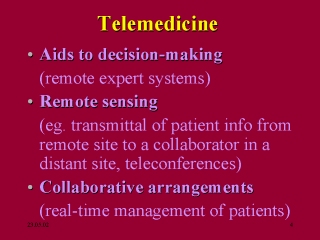 |
Telemedicine can
be divided into three areas:-> Aids to decision-making. As an aid to
decision-making, telemedicine includes areas such as remote expert systems that contribute
to patient diagnosis or the use of online databases in the actual practice of medicine.
This aspect of telemedicine is the oldest in concept and is a focus of current work.
-> Remote sensing. Remote
sensing consists of the transmittal of patient information, such as electrocardiographic
signals, x-rays, or patient records, from a remote site to a collaborator in a distant
site. It can also include transmittal of grand rounds for medical education purposes or
teleconferences for continuing education.
c) Collaborative arrangements for the real-time management of patients at a distance.
Collaborative arrangements consist of using technology to actually allow one practitioner
to observe and discuss symptoms with another practitioner whose patients are far away.
This raises important issues of referral and payment arrangements, staff credentialing,
liability, and licensure potentially crossing state lines. Two-way work stations which
provide smooth digital motion pictures have been integral to the long distance, real-time
treatment of patients. As new technology is found, collaborative arrangements are the
future of telemedicine. |
